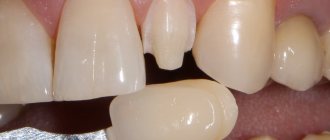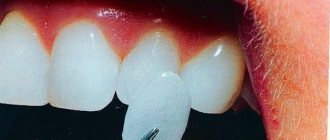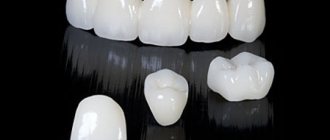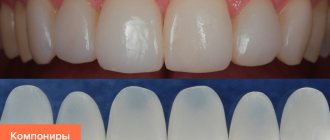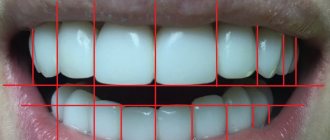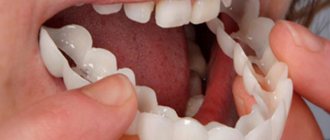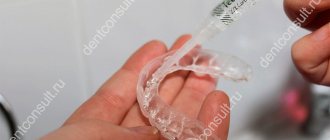Do you dream of a flawless Hollywood smile? Do you want your teeth to be perfectly straight and white, like those of Insta stars and celebrities? This is possible, and even for a very reasonable budget. At the 32 Dent clinic, you can completely restore your teeth using high-quality and modern veneers. Just a couple of visits to the dentist’s office - and you will get the same result that will pleasantly impress you and those around you!
Veneers are thin overlays 0.2 - 0.7 mm thick, which are fixed to the outer surface of their teeth using a special adhesive. They can also be called microprostheses, plates, prostheses, but the essence does not change. This is the most effective method in a couple of visits to the dentist to transform unaesthetic teeth into absolute perfection in color, shape and transparency!
This is interesting! The very first dental veneers appeared at the beginning of the 20th century in the USA, and they were intended for Hollywood stars (hence the phrase “Hollywood smile”). Initially, these were unnaturally white and rough in structure ceramic plates of impressive thickness, which made their teeth larger - it was visually noticeable that there were dentures in the mouth.
Modern designs are more advanced, but at the same time they look natural and aesthetically pleasing. You can easily verify this by looking at examples of the work of doctors at the 32 Dent clinic. The result will impress you!
Who is recommended for veneers and who is not?
In principle, any patient can get dental veneers if they have the funds and the desire. Most often, veneers are installed on teeth for the following reasons:
- not satisfied with the natural color of your teeth;
- there are stains or microcracks on the tooth surface that you want to disguise;
- if there are three (small distances a few millimeters wide);
- in cases where teeth are prone to increased wear at the edges;
- if there are minor orthodontic defects, for example, the tooth is slightly rotated, or mild crowding is diagnosed.
Note!
Even the most modern whitening technologies are not able to give tooth enamel such impeccable whiteness as microprostheses. That is why more and more patients are inclined to install veneers and make their dream of incredibly beautiful teeth come true! Like any restoration procedure, the installation of veneers has its contraindications. It will not be possible to install dental microprostheses if:
- the patient suffers from bruxism - otherwise, microprostheses will constantly break;
- when your teeth are loose and in poor condition, prosthetics will help here (possibly together with implantation);
- if the enamel thickness is insufficient or it is destroyed, then the microprosthesis will not hold;
- the teeth are naturally underdeveloped, too small - the structures simply will not be fixed on the surface;
- there are acute diseases of the ENT organs, problems with the heart and blood vessels, tumors, etc.
Relative contraindications are problems with bite and caries - these issues can be treated, and only after that you can work on the aesthetics of your smile.
Note! If a tooth has been restored by more than 60%, it has a large filling, and it is not advisable to install onlays on it. This can lead to subsequent destruction of the crown, and the patient will already spend a considerable amount on the installation of dental microprostheses. Perhaps in this case, prosthetics at the 32 Dent clinic will help.
What you need to be prepared for when deciding to install veneers on your teeth
Unfortunately, patients are not always aware of all the points associated with these structures.
- The crown must first be ground. In most cases, when installing veneers, the enamel must be prepared (remove a microscopic layer) - otherwise, the overlay will stick out and provoke an unattractive effect. But in this case, you can choose an alternative - ultra-thin lumineers, which are attached to the enamel without pre-turning, but at a price - they are much more expensive than conventional onlays.
- Not for life! When deciding one day to put veneers on your teeth, be prepared that in a few years you will have to replace them with new ones. Even the best pads won't last a lifetime. If we are talking about composite veneers, they will have to be replaced after 5 – 7 years.
- Beware of caries! Unfortunately, even the best and well-installed structures do not guarantee that caries will not develop under them. Therefore, experts recommend that patients with veneers monitor their oral hygiene even more carefully and undergo regular preventive examinations in the clinic.
- Pleasure is not cheap. This is not only about the beauty of teeth, but also about the need to invest periodically. So, for example, if one pad breaks or comes off, it will have to be replaced with a new one, which also costs money. However, by investing in your health and beauty, you get much more!
Ceramic veneers: price for 1 tooth in Moscow
1. Ceramic veneers. These veneers are made from zirconium dioxide and medical porcelain and are characterized by extreme strength, color fastness, and durability. Porcelain-zirconium veneers are visually indistinguishable from natural teeth. They have minimal thickness - only 0.5 millimeters. The price of veneers for ceramic teeth at Vanstom dentistry in Moscow (Baumanskaya metro station) is from 14,000 rubles (for 1 veneer). You can get detailed advice from the clinic’s specialists!
What types of veneers are there? Which is better to choose?
Conventionally, three groups of restoration structures for teeth can be distinguished, if we take into account the specifics of their installation:
- Direct – plates that are installed directly in the dentist’s chair. The specialist first grinds the tooth, after which he applies the composite material layer by layer - by analogy with artistic restoration. As a result, it is possible to obtain a beautiful “new” tooth in shape, color and transparency. The main advantage of direct overlays is their price. The main disadvantage of direct structures is that over time, the composite material still darkens, turns yellow, and the aesthetics are no longer the same.
- Indirect - onlays that are made in advance using impressions taken from the patient’s ground teeth. After the plates are ready, they are tried on the prepared teeth, and then they are fixed using an adhesive composition. While the veneers are being produced in a laboratory, special temporary structures are placed on the patient’s teeth (similar to temporary dentures). The main advantage of indirect solutions is that they are more durable and do not change their color and transparency throughout their entire service life. The main disadvantage of indirect overlays is their high price compared to composite plates.
- Semi-direct – a combination of the two technologies listed above. First, impressions of the patient’s teeth are taken, and new onlays from composite material are made in the dental laboratory. The main advantage of semi-direct veneers is that their fixation to the teeth is considered more reliable. The main disadvantage of semi-direct options is that composite linings still last no more than five years; over time, they will have to be replaced with new ones.
As you can already understand from our examples of clinical cases, dentists distinguish two categories based on the material of manufacture:
- Composite – dental onlays made of filling composite. In some cases, they can be installed without first grinding down your tooth. For example, when there are microscopic cracks in the enamel, or the patient is not satisfied with the shade of the tooth enamel. A thin layer of composite material will mask these moments and allow you to achieve ideal whiteness of your teeth. There will be no visible transitions from the composite composition to the native tissues of the tooth enamel.
- Ceramic – dental plates made from dental ceramics. More advanced solutions in terms of creating ideal tooth shapes. They will help to align and achieve ideal anatomical proportions of teeth, since the structure of the material is as close as possible to the characteristics of natural enamel. At the same time, the price of ceramic analogues is three or even five times higher than the price of classic composite overlays.
Which veneers are best to choose? The question is strictly individual. To answer this, the dentist must:
- assess the condition of the patient’s teeth;
- see the condition of the jaw and exclude serious orthodontic abnormalities;
- find out the goals pursued by the patient who wants to install linings from a particular material;
- roughly be aware of the allocated budget for smile restoration.
It is important! In case of severe curvature of the teeth or pathologies of the jaw, guilt is undesirable. But the patient can always straighten the teeth first and then install veneers to get the picture of their dreams.
As practice shows, ceramic structures are still more preferable. Firstly, this is quality that will prove itself within 20 years. Secondly, it is reliable; teeth will not darken from coffee or cigarettes in a year. Thirdly, if you calculate the budget for installing composite systems every 5 years, then installing ceramic veneers is more profitable from a financial point of view.
Among the most common ceramic veneers, we note 4 directions:
- Zirconium dioxide dental veneers – the main part is made of zirconium alloy, and the top is coated with dental porcelain. They are considered one of the most reliable and durable, but in terms of their tint range and transparency they may be inferior to glass ceramic linings;
- Made from glass ceramics – so-called metal-free plates, which are made in a dental laboratory from pressed glass ceramics. The most popular plates you may have heard of are E Max CAD and E Max Press;
- Porcelain dental veneers are the “gold standard” of designs that combine optimal price and quality. Dental porcelain is the same ceramics, but with characteristics closer to natural enamel;
- Ultra-thin or lumineers are dental onlays approximately 0.02 millimeters thick. They are considered the thinnest, their installation does not require preliminary grinding of the enamel, but their cost is several times more expensive than classic porcelain ones.
Lumineers: price for 1 tooth in Moscow
3. Lumineers. A separate type of veneers, which is popularly called “Hollywood veneers.” These microprostheses are ultra-thin and ultra-strong; their fixation does not require preliminary grinding of the enamel, which has a positive effect on the health of the teeth and oral cavity in general. But at the same time, Lumineers are the most expensive veneer option available.
Prices for ultra-thin lumineers start at 80,000.
The main difference between lumineers and conventional veneers is the use of special technologies in their production. The use of innovative methods partly explains the high price of lumineers. The finished Hollywood veneer is thin (its thickness does not exceed 0.2 millimeters), and perfectly matches the natural shade of the patient’s tooth enamel. Separately, it is worth noting the incredible strength of the veneer - its useful life is 20 years or more.
Which veneers to choose for artistic restoration of teeth in the smile area and what factors to consider when choosing, in addition to price? A detailed consultation from specialists at our dental clinic in Moscow, Vanstom, will help you get a detailed answer to these questions. We are located a 5-minute walk from the Baumanskaya metro station. Make an appointment right now - just by dialing our phone number! Already at the first appointment, the doctor will help you choose the right veneers by type and tell you about the cost of installing turnkey veneers.
Installation of veneers: features, important nuances that the patient should know better about
The indirect method involves 3 steps:
- Preparation. First, the tooth enamel is ground down a few tenths of a millimeter - a thin layer of enamel is removed. Then the dentist makes impressions of the patient’s also prepared teeth, after which he covers them with special protective caps - for the period of time while the veneers are produced in the laboratory;
- Visualization. Computer model with “before” and “after” effect. In a 3D program, the dentist creates a virtual model of teeth and clearly demonstrates how it was and how it will be after. The picture is usually impressive and motivating;
- Installation of veneers - your new perfect smile is ready! The dentist fixes the onlays on the tooth enamel, and the patient evaluates the final result.
Installation of microprostheses using the direct method also involves 3 steps:
- Preparation. The dentist removes a small layer of tooth enamel for the patient and prepares the teeth for further restoration;
- Installation of composite structures. Layer by layer, the dentist distributes the composition over the surface of the enamel, while each of them is illuminated with a lamp to “seal”;
- Polishing and finishing to perfection. The enamel surface is carefully polished, the shape of each tooth is brought to perfection.
Specifics of the production of composite veneers
The easiest way to make composite veneers is to apply a special composition to the surface of the patient’s teeth right in the dentist’s office. During the procedure, the doctor first prepares the enamel coating of the tooth for manipulation by removing a thin layer from it, and then applies the composite in layers to the treated surface. If you are interested in a low price for restoring teeth with veneers, composite structures will be the optimal solution.
Composite veneers are also made from an individual impression of the patient’s teeth, which is taken during an examination in the dentist’s office. An impression is made of the teeth that have been ground for the onlay, and then the technician models the veneer using it. Veneers made from an individual impression are stronger than overlays created by layer-by-layer application.
Price question: how much does it cost to install veneers?
As we already said, dental veneers are not cheap, but they are worth it!
Approximate cost of microprostheses:
- Composite ones are the most budget-friendly. The cost of one unit is approximately 7 thousand rubles;
- Ceramic microprostheses, which are manufactured in a dental laboratory, cost approximately 20 thousand rubles per unit;
- Ceramic dental veneers made at the 32 Dent clinic will cost the patient about 15 thousand rubles per unit;
- Lumineers are the most expensive - from 50 thousand rubles per unit.
Rules for choosing veneers
There are two main types of veneers - some are made from ceramics, and others are made from a special composite material. The former have a fairly long service life - up to 15 years, the latter serve much less - up to 5 years.
In addition, ceramic linings are different. It depends on the material itself - ceramics - which can be different (porcelain, E.max glass ceramics, zirconium dioxide).
The type of ceramics affects the appearance of products, their strength, durability and other characteristics.
The cost of veneers depends on the material from which it is made and the manufacturing technology.
In addition, various technologies are used in the production of dental onlays. They are made by pressing, by applying layers or using the CAD/CAM technique (milling on a special programmable machine). The technical and aesthetic characteristics of overlays largely depend on the method of their production.
How can you save on installing veneers?
There are two ways to go. Place veneers on individual teeth for the patient. For example, for 10 units of the upper jaw - provided that your teeth are in good condition. You can whiten the enamel of your teeth, but the result will not always be perfect.
There is also a solution to take advantage of the favorable conditions of clinics. Thus, 32 Dent dentistry regularly holds promotions and special offers for the installation of veneers. There are opportunities to install dental microprostheses at a discount of 15% to 50%. The quality of work is at the highest level, as are the guarantees.
Hit list of questions and answers about veneers
Do veneers ruin your teeth?
Answer: teeth are spoiled by carious lesions, neglect of hygiene rules, lack of regular visits to the dentist, poor nutrition, and bad habits. Veneers, made of first-class material and installed by a professional dentist, on the contrary, protect the enamel from harmful external influences.
Is it painful to install?
Answer: no, it doesn't hurt. The procedure is performed under local anesthesia in a comfortable environment. It is important! There is no need to remove dental nerves during installation.
How long will it take to install?
Answer: on average, from 5 to 14 days or 2 to 3 visits to the dentist’s office.
Dental clinic "32 Dent" specializes in the installation of dental veneers on a turnkey basis. Both budget-class microprostheses and premium solutions are available, including patented American lumineers. Schedule an initial consultation with your doctor to choose the best path to restoring your smile with veneers. The smile will be beautiful and at the same time natural. Take action!
Contraindications and restrictions
Since we objectively consider veneers, with their advantages and disadvantages, we note that they have an important practical disadvantage - they are not suitable for everyone.
Doctors do not recommend installing these microprostheses in the following cases:
- There are no premolars (“sixes”), so there are difficulties with chewing function.
- The bite is seriously deformed.
- The incisor is significantly damaged, and therefore it is difficult (there is nothing) to attach the plate.
- The volume of the filling exceeds 50% - this also reduces the reliability of fixation.
- The patient is interested in martial arts, contact sports, or other activities that can cause jaw injuries.
- A person has bad habits that contribute to the appearance of caries or other diseases, for example, bruxism or a passion for cracking nuts.
In any of these situations, you can use some other restoration option. Moreover, such plates must be worn with caution so as not to damage them.
